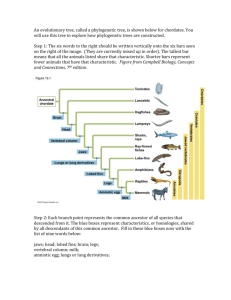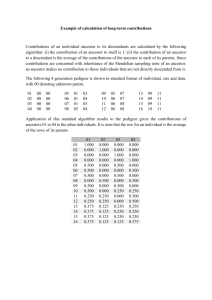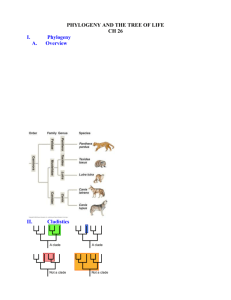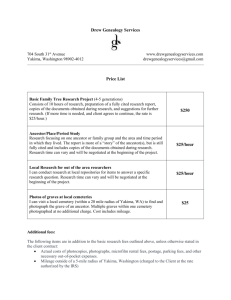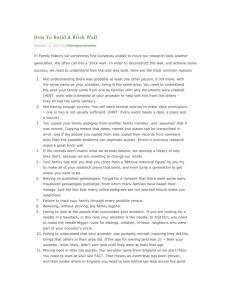Name(s): Period: ___ Due Date: ______ Evolution Review Activities
advertisement
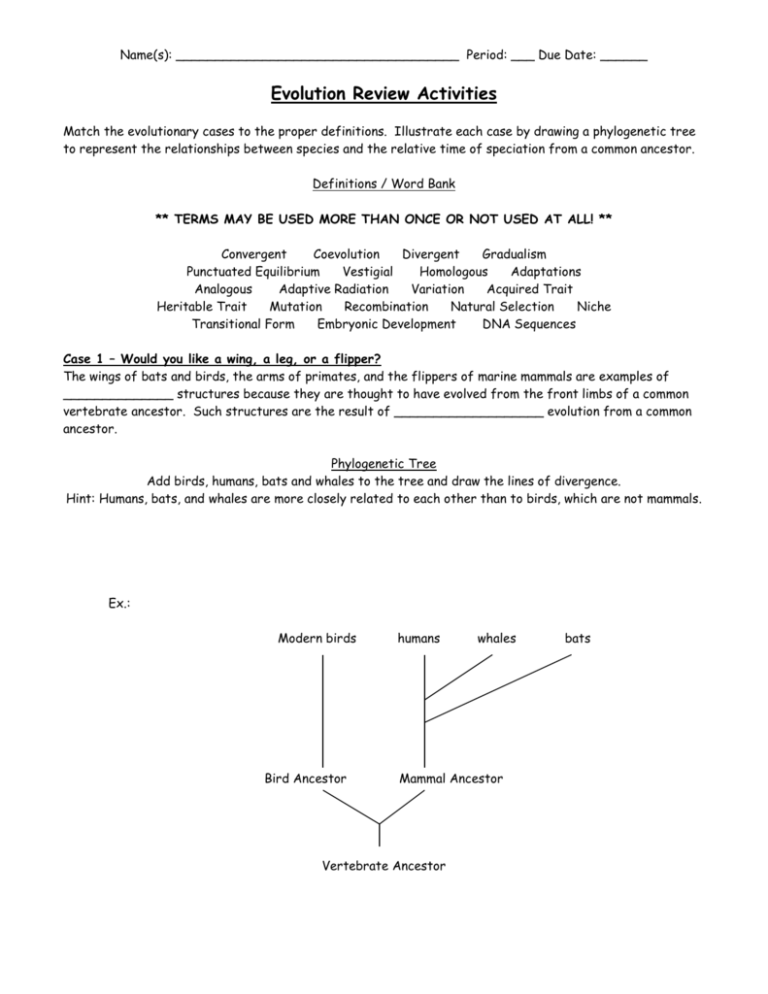
Name(s): ____________________________________ Period: ___ Due Date: ______ Evolution Review Activities Match the evolutionary cases to the proper definitions. Illustrate each case by drawing a phylogenetic tree to represent the relationships between species and the relative time of speciation from a common ancestor. Definitions / Word Bank ** TERMS MAY BE USED MORE THAN ONCE OR NOT USED AT ALL! ** Convergent Coevolution Divergent Gradualism Punctuated Equilibrium Vestigial Homologous Adaptations Analogous Adaptive Radiation Variation Acquired Trait Heritable Trait Mutation Recombination Natural Selection Niche Transitional Form Embryonic Development DNA Sequences Case 1 – Would you like a wing, a leg, or a flipper? The wings of bats and birds, the arms of primates, and the flippers of marine mammals are examples of ______________ structures because they are thought to have evolved from the front limbs of a common vertebrate ancestor. Such structures are the result of ___________________ evolution from a common ancestor. Phylogenetic Tree Add birds, humans, bats and whales to the tree and draw the lines of divergence. Hint: Humans, bats, and whales are more closely related to each other than to birds, which are not mammals. Ex.: Modern birds Bird Ancestor humans whales Mammal Ancestor Vertebrate Ancestor bats Case 2 – Darwin’s Finches When Darwin observed the different varieties of finches in the Galapagos Islands, he noticed that each different species occupied a different ____________ in the environment. The different species had different beak sizes and shapes depending on the type of food they ate. Darwin hypothesized that the different species of birds in the islands had originated from a common ancestor species found on the mainland. This type of evolution, in which one species gives rise to many varieties, is termed __________________. Phylogenetic Tree Draw the lines showing speciation of many varieties from one common ancestor. The common ancestor should continue to the present time, as it was not extinct. Suggestion: Label the modern species A, B, C, D, etc. Ancestral Bird Species (mainland) Case 3 – Symbiosis – Arms Race or Not The symbiotic relationship between a predator and its prey is termed predation. This close association between two species results in a “fit” between the two species. For example, while lions have ____________ for hunting (claws, sharp teeth, coat coloration that blends with the environment, and fastmoving bodies), antelopes have adaptations for escaping predators (fast reactions, coat coloration that blends with the environment, and fast-moving bodies). This type of evolution, in which two species affect each other’s evolution, is termed _________________. Symbiosis can also be mutual, as is the case with plant and pollinator species, in which both species benefit. Case 4 – Was Darwin the only one thinking about evolution? Characteristics that are passed on to offspring are termed _______________. Darwin inferred that, due to differential survival and reproduction, the process of ___________________ favors some variations of these traits. Traits that cannot be inherited are called _______________. Lamarck failed to differentiate between these two types of traits. He hypothesized that living things constantly strived to “improve” themselves, and that __________________ were inherited by offspring. Wallace came to the same conclusions as Darwin, i.e., that evolution happened through ___________________. Case 5 – Good theories allow for correct predictions Suppose a comparison of anatomical structures and embryological development suggests that birds and reptiles are more closely related than birds and mammals. A scientist could test this hypothesis by making a prediction about another type of evidence of evolution found in living things. An evolutionary biologist studying the relationships between these groups of animals would expect to find more differences between the _________________ of birds and mammals than between the __________________ of birds and reptiles. Case 6 – He who can swim gets the fish! Seals and penguins are thought to have evolved from different quadruped, vertebrate ancestors. Penguins are birds, which are thought to have evolved from dinosaurs. Seals are mammals, thought to have evolved from a land mammal. However, because both seals and penguins feed in the ocean, they have evolved similar adaptations for swimming: their front limbs have evolved into flippers, their hind limbs have become shortened and modified (webbed/fused), and their bodies have become smooth and tear-drop shaped. The limbs of seals and penguins are _______________ structures because they were inherited from a common ancestor, and their bone structure is very similar. Phylogenetic Tree Add penguins and seals to the tree and draw the lines showing the points of divergence in their evolution. Dinosaurs Mammals Vertebrate Ancestor Case 7 – Are T-Rex and Hummingbirds relatives? Birds are thought to have evolved from dinosaurs. Fossils of Archaeoptherix, a feathered creature that has bird and dinosaur characteristics, provide a _______________ between dinosaurs and modern birds. Phylogenetic Tree Place modern birds and Archaeoptherix in the tree and draw the lines of divergence. Modern Reptiles Dinosaurs Modern Reptile Ancestor Reptile Ancestor Case 8 – How fast does it happen? Darwin thought evolution happened gradually as changes in a species accumulated through long periods of time. This is termed _________________. Another theory, called _______________________, states that evolution results from periods of fast genetic change in a species followed by periods of relative stability. Phylogenetic Tree 1 Phylogenetic Tree 2 Case 9 – What lovely eyes you have! Light-sensing structures have evolved more than once in the history of life on earth. For example, humans and octopuses have eyes, but their eyes are thought to have evolved separately, i.e., they were not inherited from a structure in their common ancestor. Humans are vertebrates, while octopuses are invertebrates. In fact, the internal structures and developmental processes of human eyes and octopus eyes are quite different. The two types of eyes are an example of _____________ structures. Structures like these are the result of ______________ evolution. Phylogenetic Tree Place humans and octopuses on the tree and draw the lines showing their divergence from a common ancestor. Vertebrates Invertebrates Common Invertebrate Ancestor Making Generalizations Answer the questions using what you have seen in the cases above and the examples seen in class. 1. What type of structure arises from convergent evolution? 2. What type of structure arises from divergent evolution? 3. Because all living things share a common ancestor sometime in the past, they all can be said to diverge at some point in the evolution of life. What should be at the base of a phylogenetic tree that shows the relationship between all groups of living things?
